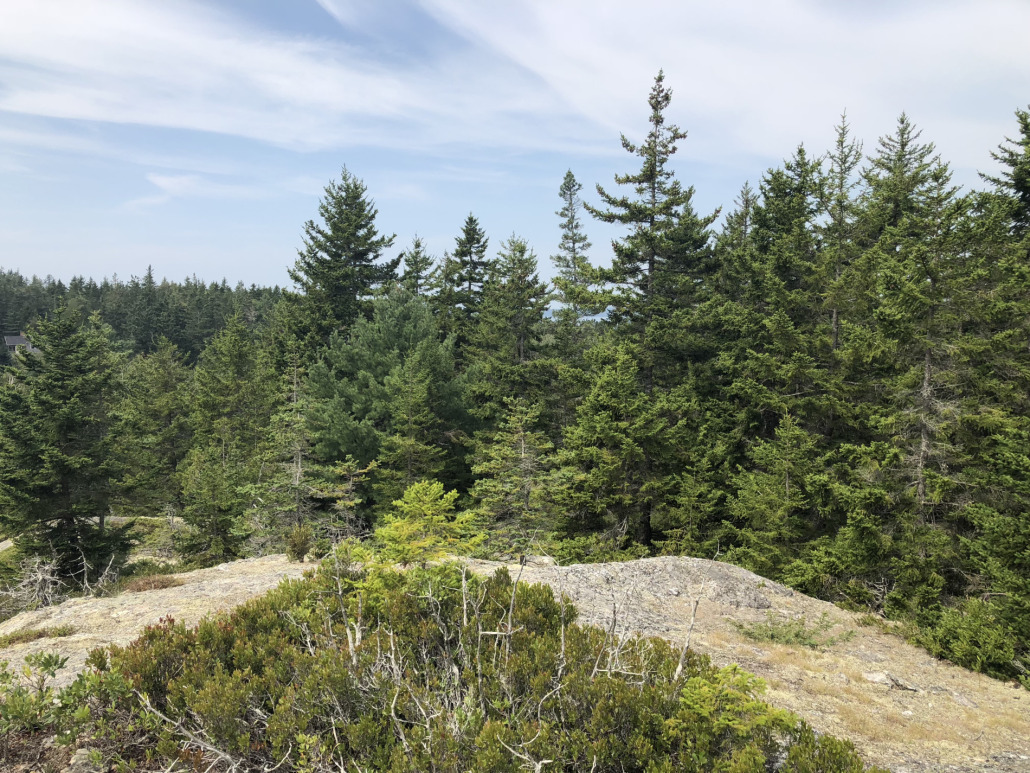LISA TOLMAN WOTTON NATURE PRESERVE, LITTLE DEER ISLE
This 42-acre preserve holds steeply wooded hills and ravines, and a northern white cedar swamp. Explore trails through cedar groves and over a high rocky knoll, historically known as Spiney Ledge, which provides a limited view of Penobscot Bay through the trees.
ACTIVITIES TO ENJOY AT LISA TOLMAN WOTTON:
- Hiking
- Trail Running
- Photography
- Moss and Lichen Observation
2.6 MILE TRAIL SYSTEM:
Traditional Rating: MODERATE
Accessibility Rating: HARD
EXPLORE THE PRESERVE:
Walk through an old field that marks the site of a former homestead. Beyond the field, the trail enters wonderful examples of spruce-fir forest and northern white cedar swamp. The preserve has many unique features to enjoy including streams, springs, wetlands, ‘Spiney Ledge’ – a rocky ledge with distant views, a rock-bound gorge, steeply wooded hillsides, and a beach on Blastow Cove for hand carry access. Please see our for more information.
PLEASE FOLLOW THESE GUIDELINES:
- Day Use Only – no camping or overnight parking
- Hunting is not permitted – Wildlife safety zone.
- Pets allowed under voice control.
- No fires allowed.
- No ATVs allowed.
- Leave it better than you found it.
- Respect the privacy of our neighbors.
DIRECTIONS TO THE PRESERVE
From the Deer Isle bridge heading south, turn right before the Welcome Center on Little Deer Isle onto Eggemoggin Road. Drive northwest for .2 miles and turn left onto Blastow Cove Road. Travel 1-mile down Blastow Cove Road. The preserve’s parking area will be on your right, just across from where Blastow Cove Road takes a sharp turn to the left.
GET TO KNOW THE FLORA & FAUNA
With Ecologist, Dr. Ken Crowell, & Naturalist, Marnie Reed Crowell:
“This preserve is a great place to learn to recognize tree species. White spruce, a good colonizer, has repopulated the edges of the entryway field here. It grows near the shore and has a pale color not quite like that of the more common Red Spruce inland on the island. A closer look shows us that the needles are flattened as if they had been run through a pasta machine. This tells us that these are Northern White-Cedar, Thuya occidentalis.
The larch, or tamarack, is a conifer that loses it needles. In Fall they will be a lovely pale gold. In Spring these trees will have dark red, new cones.
Mountain Maple, a small understory tree, can be distinguished by the leaves’ three large peaks, and large coarse teeth on the edges of the leaves.
When you come to the bridge, you will see the white or paper birch on the right. The teeth on the perimeter of the leaves are helpful for differentiating this from other birch species. Wide on White. White birch also has dark scars marking where the branches once were. White birch bark peels in wide sheets.
Yellow birch leaves are narrow, the perimeter teeth are narrow, and the bark peels in narrow strips.
The glaciated terrain has significant outcrops of the Castine Formation, metamorphized layers of lavas and other volcanic deposits. Many of the rocks are covered with lichens, mosses, and liverworts. Color will help you initially differentiate between the pale lichens, the green mosses, and Reddish liverwort, Frullania, which you will also spot on some tree trunks.”
Check Out the FULL Virtual Guided Walk through Lisa Tolman Wotton Nature Preserve
STORY OF PUBLIC ACCESS
The preserve was generously donated to IHT in 2017 by a family who wanted to protect their beloved property as a preserve and maintain it for public use.
HISTORY OF LISA TOLMAN WOTTON NATURE PRESERVE
Noah Blaster settled at what is now the Lisa Tolman Wotton Preserve on Little Deer Isle near Swains and Blastow Coves. Born in Ireland, Blaster served in the British navy in the American Revolution. Three generations later the family changed the name to Blastow – more English like the names on Deer Isle itself. Neighbor William Swain also served the English, in the garrison at what is now Castine.


